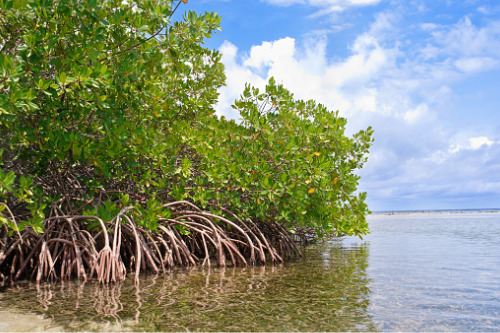

Insurance could cost-effectively help protect and restore mangrove forests, according to a report published by The Nature Conservancy and the University of California, Santa Cruz, and supported by AXA XL. Mangrove forests can offer increased resilience to coastlines and help protect against coastal flooding.
The report, Reducing Caribbean Risk: Opportunities for Cost-Effective Mangrove Restoration and Insurance, identified 3,000 kilometers of coastline in 20 states, territories and countries in the Caribbean region where post-storm mangrove restoration – which could be paid for by insurance – would provide flood protection benefits that “significantly outweigh” the cost of rehabilitating the forest. The report said that although the US and the Bahamas have the most robust insurance markets in the area, mangrove forests’ protective benefits are also significant in Jamaica and the Dominican Republic, due to those countries’ high population densities.
Globally, mangrove forests protect 15 million people from flooding and reduce flood damages by $65 billion every year, AXA XL said. The first 100 meters of mangrove forests are especially important, as they can lower wave height by up to 66%.
The report said that a parametric insurance policy based on wind speed could be most feasible, and could be paired with a traditional indemnity policy to cover both short-term and long-term restoration efforts.
“As part of our Ocean Risk Initiative, we’re looking to develop insurance and finance products that incorporate nature-based solutions – including mangroves – to help close the protection gap and build resilience at local, regional and global levels,” said Chip Cunliffe, director of sustainable development for AXA XL. “AXA XL is an innovator in this field, and in line with AXA Group’s focus on climate and biodiversity, we are using our risk management expertise to look for new ways to reduce community vulnerability to coastal flooding, which is expected to increase as sea levels rise. A specific mangroves solution could provide effective protection to coastal communities.”
“With increasing sea levels and waves, more communities will be exposed to impacts from extreme weather,” said Professor Michael W. Beck of UC-Santa Cruz. “Mangroves provide a cost-effective first line of defense protecting people and property from these hazards.”
The Nature Conservancy, which also helped develop and launch the first coral reef insurance policy off Quintana Roo in Mexico, is helping to lead the new approach, AXA XL said.
“This report represents an important milestone in our work to develop insurance solutions that can help protect valuable coastal ecosystems that provide so many vital services, including enhancing resilience to storm surge and coastal erosion,” said Mark Way, director of coastal risk and resilience at The Nature Conservancy. “We are about to begin a second phase of research to build on this report and deepen our understanding of technical aspects and the potential demand for an insurance product to protect mangroves in particular locations in the Caribbean region.”
